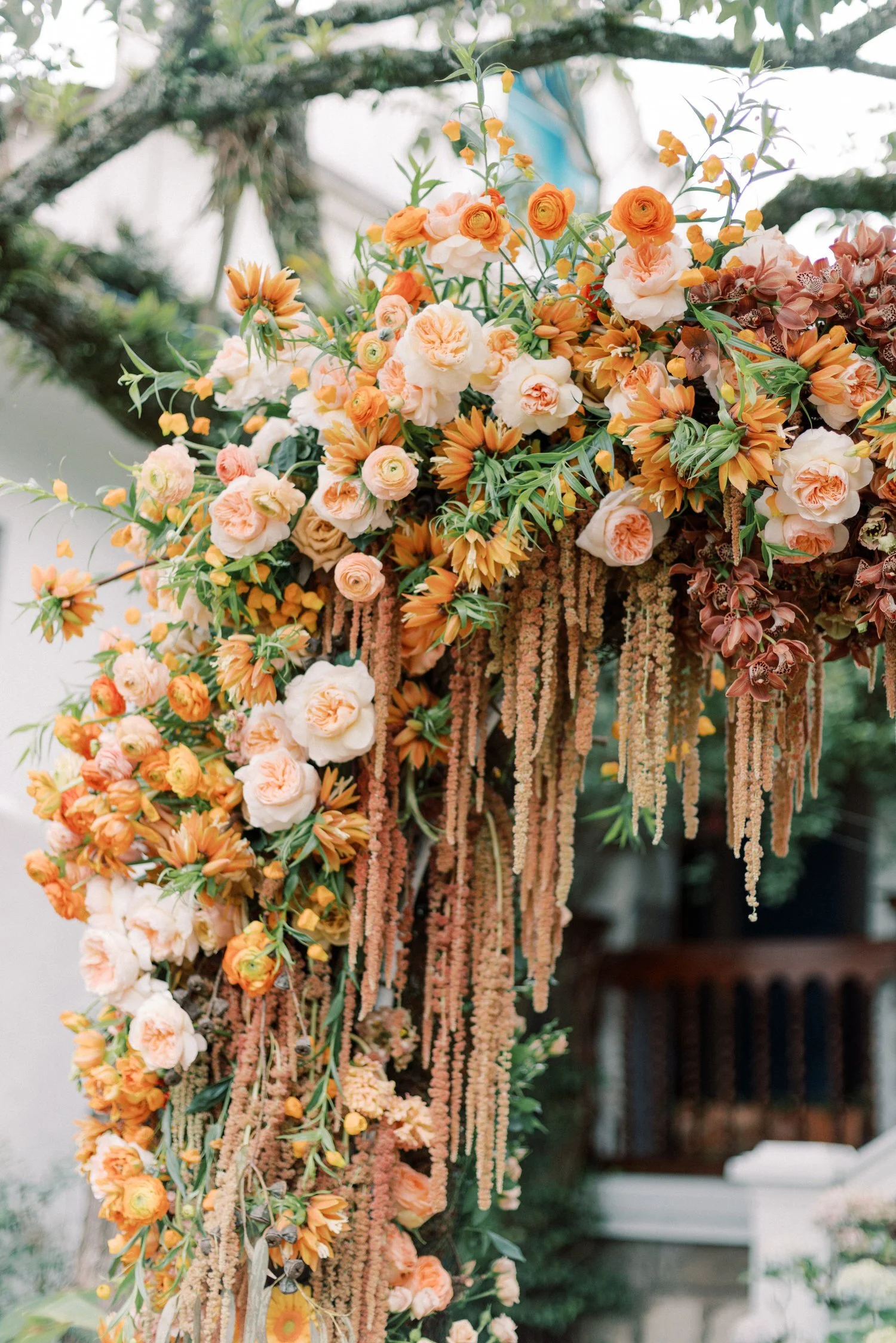Sturdy Foliage + Flowers for Large-Scale Floral Installations
The challenge of a florist is to create perfectly-timed art out of natural, fleeting elements.
Just as a chef would, we carefully select and gather our ingredients, coax them to perfection, arrange them thoughtfully, and “serve” them to our clients.
As a sustainably-minded studio florist and teacher I love bringing artful large-scale installation design requests to life and I’ve come to see conventional hydration methods (floral foam, tons of water tubes) as overkill.
I lean heavily on these reliables when crafting my “recipes”.
Most of these pieces only need to “perform” for the length of a single event, and most of the materials in these large designs won’t be taken home by the client, so I view these as compostable short term performance pieces. I set them up to look fresh for the 6-8 hours they’ll be viewed for and compost them after the event.
To ensure success, I depend on long-lasting, fresh ( or naturally dried ), sturdy materials - reliables, as I call them - to execute foam-free, low-water and zero-waste designs that look great for the length of an event.
I lean heavily on these reliables when crafting my “recipes” because I don’t want the design to depend on weighty, cumbersome, costly, wasteful, or time-consuming conventional hydration methods. So I curated a list of trusted foliage and flowers to start finding your own favorite “ingredients”!
I want you to have this design freedom, too!
Here is a collection of musings and considerations for your success:
STEMS
Unlike with wearables, stem-length is important to the success of these large-scale designs. In order to achieve an abundant look and size, designers often want to maintain as much stem length as possible — It’s important to know what stems will stay rigid and perform well during the length of an install, so I’ve tagged these materials in the free download above. These are the materials I’ve tested and relied on over the years to build sturdy, worry-free designs.
WATER
I realize that delicate materials which need a water source to last the length of the event (for example: garden roses, sweet pea, clematis, or lilac) need to be addressed, as they are some of the most desirable materials. Their stems will wilt with time, so they are added to the structure of the installation in large water tubes, Eco-fresh bouquet wraps, Holly Chapple’s installation mechanics for Syndicate Sales, or into the built-in water receptacles that are part of many welded floral design structures.
STRUCTURES
In terms of structure, much can be done with steel rods, chicken wire, water, and a great welder. There are many clever ways to build water receptacles into welded pieces — check out @floralfabrications and @thevesselrentalco for ideas or to commission your own welded structures. In my experience, these investments pay for themselves after the first use! If this feels out of reach, consider partnering with a nearby floral friend to commission some pieces that you can both use, or renting commissioned structures to other area florists while not in use.
ENVIRONMENT
It is vital to consider your environment when choosing materials for installations, as well as how long the design will need to “perform” for, and where it will be placed. Remember the contributors to wilt: temperature, light, wind velocity, and relative humidity. If you live in a hot, arid place, be mindful when choosing materials. Consider plants that do well where you live. Consider using plants that are still in soil, or if you must, spray your finished design with an anti-transpirant to prevent water loss.
HYDRATION
You can design your components a day ahead to optimize hydration (and longevity), too. Spray them generously with water, tuck them into airtight containers (or contractor trash bags) and allow them to take moisture in through the pores in the surface of their petals, stems, and leaves before installing them at the event.
REUSABLES
Another great sustainability tip is to lookout for materials that you can use over and over again in your installation designs. Materials like seed pod clusters, grasses, or cotinus fluff work well and can often be locally and responsibly foraged (and disposed of).
I’ve curated this list of reliable foliage and flowers for installation design to help you as you craft your plans. These are materials I use and trust, but please keep your specific environment and display needs in mind.
Download my curated list of reliables for installation design:
We respect your privacy.
Ready to go further?
For more on the hydration chamber, and how to make your own floral wearables, check out my book “The Art of Wearable Flowers,” and my extensive library of self-paced online classes.




